Lea Wait's Blog, page 80
September 23, 2022
Weekend Update: September 24-25, 2022
 Next week at Maine Crime Writers there will be posts by Dick Cass (Monday), Matt Cost (Tuesday), and Charlene D’Avanzo (Thursday).
Next week at Maine Crime Writers there will be posts by Dick Cass (Monday), Matt Cost (Tuesday), and Charlene D’Avanzo (Thursday).
In the news department, here’s what’s happening with some of us who blog regularly at Maine Crime Writers:
 From Kaitlyn Dunnett/Kathy Lynn Emerson: The big news at our house is that my husband’s first full length fiction is now available as an e-book. Well, Hell: The Yarns of Bobby Wing, Constable of Skedaddle Gore, Maine, had its origin in three short stories that appeared in three successive editions of Best New England Crime Stories. The protagonist, Bobby, moved to Skedaddle Gore when he retired from the Coast Guard and accepted the job as constable because the extra income would help cover his tab at Sally’s Motel and Bar and Live Bait and Convenience Store. The job description was vague: just handle the “little things” that come up from time to time. He doesn’t carry a badge or a gun and isn’t allowed to arrest anyone, but somehow those “little things” end up including everything from a severed head to a body on ski lift. But don’t worry. It’s not all murder and mayhem. There’s plenty of Maine humor, too. Here are the links to buy the e-book:https://books2read.com/u/mZEeLp
From Kaitlyn Dunnett/Kathy Lynn Emerson: The big news at our house is that my husband’s first full length fiction is now available as an e-book. Well, Hell: The Yarns of Bobby Wing, Constable of Skedaddle Gore, Maine, had its origin in three short stories that appeared in three successive editions of Best New England Crime Stories. The protagonist, Bobby, moved to Skedaddle Gore when he retired from the Coast Guard and accepted the job as constable because the extra income would help cover his tab at Sally’s Motel and Bar and Live Bait and Convenience Store. The job description was vague: just handle the “little things” that come up from time to time. He doesn’t carry a badge or a gun and isn’t allowed to arrest anyone, but somehow those “little things” end up including everything from a severed head to a body on ski lift. But don’t worry. It’s not all murder and mayhem. There’s plenty of Maine humor, too. Here are the links to buy the e-book:https://books2read.com/u/mZEeLp
Kate Flora: I just recorded a podcast for Murder We Write. A lot of fun. If you’re interested in some of my thoughts on writing, and upcoming books, you can find it here:
https://podcasts.apple.com/us/podcast/murder-we-write-episode-2/id1635664204?i=1000580133927
An invitation to readers of this blog: Do you have news relating to Maine, Crime, or Writing? We’d love to hear from you. Just comment below to share.
And a reminder: If your library, school, or organization is looking for a speaker, we are often available to talk about the writing process, research, where we get our ideas, and other mysteries of the business, along with the very popular “Making a Mystery” with audience participation, and “Casting Call: How We Staff Our Mysteries.” We also do programs on Zoom. Contact Kate Flora
Joyce? Wordsworth? They’re just like us!
For several years, I was a judge in nationwide self-published book contest. I was a first-tier judge, which meant I read a hundred or more books, sending one for every batch of 25 back to the next tier. Duties included ranking each on a 1-5 scale for several criterea (character development, structure, grammar, etc), and also giving a 200 to 300-word critique. (Top tip: If you’re self publishing, pay for an editor, for the love of god). I always used the “critique sandwich” approach — positive opening, the real criticism, positive ending. Example: “You obviously worked very hard on this book… to bring it up to the next level, you may want to consider… you should be proud of your accomplishment.”
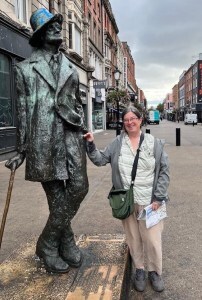
James Joyce and me in Dublin.
Sometimes — often — it was very hard to find positive things to say. One memorable one that I struggled with was a stream of consciousness mish-mash with no attention to the rules of punctuation, spelling, sentence structure, or anything else that resembled writing. The writer responded to my critique (an option they had but, in my memory, only two writers — both male and jarringly bad — used). His reply was, basically, “James Joyce wrote like this and he was considered a genuis!”
My rule with that contest was the same as when I was a newspaper editor — if I got a ridiculous email from someone who just didn’t get it, they got one brief and to-the-point response. To this fellow, I wrote something like, “Joyce understood the rules enough to know how to break them.” (Not that this is what this is about, but another tip for aspiring writers: Know the rules in and out before you break them, and if you do, have a plan for it. Don’t just break them because you’re too lazy to write correctly.)
I knew what I spoke of regarding Joyce — one piece of my very excellent liberal arts education was a semester on Joyce from one of the top Joyce scholars of the era. I’m embarrassed to say that the professor, Ed Callahan (who I also had for Shakespeare), was awesome, but I struggled mightily to understand what I was reading and I likely got a bad grade. I plan to revisit Joyce now that I’m older, smarter and on ADHD medication.
I enjoyed being an English major. Besides critical thinking skills and all sorts of stuff about literature and writing, I also learned things that no one in high school ever told me. Thoreau thought Walt Whitman was a slob! Thoreau, while “roughing it” at Walden Pond would go to the Emerson’s for lunch every day, where Mrs. Emerson would cook him a nice hot meal! Etc. I don’t rememember learning anything like that about Joyce, though. So I was delighted to learn, when I was in Dublin and visited the fantastic (but flawed) brand-new Museum of Literature in Ireland, that Joyce was, well… kind of whiner.
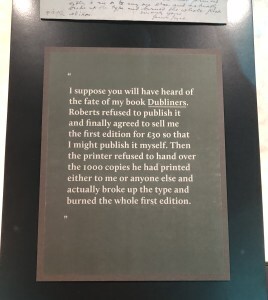
Joyce complaining about his publisher to Yeats.
The museum has an entire floor dedicated to Dublin’s favorite writer — as it should. Among the exhibits are letters he wrote to W.B. Yeats complaining about his publisher and asking for help.
In one he complains that the potential publisher refused to publish his book “The Dubliners,” then sold it back to him, but the printer destroyed all the copies. I look at this letter as just softening Yeats up, because the next letter, written on Christmas day no less, asks Yeats to help him get the book published.
The exhibits imply the two guys didn’t know each other well, but were acquainted. I can picture Yeats sitting there saying, “WTF, can’t this guy get a grip? I have my own issues to deal with!” One of the flaws of the museum — a blog post for another day — is that they have very little on Yeats. So we don’t know how he felt about Joyce.
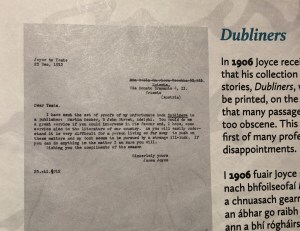
Joyce closing the deal by asking Yeats for help.
But, as we all know, Joyce eventually got the attention he deserved, whether Yeats helped him out or not.
A week or so after my visit to Dublin, I was in England’s Lake District (it was a great trip with my sister Liz — another blog post for another day), and visited Dove Cottage and the Wordsworth Museum. It was interesting to see that Wordsworth, too, had written whiney letters to people of influence complaining about publishers and more.
Don’t worry, I did have more takeaways about these two writers than the whininess. For instance, as I read Wordsworth’s “Boat Stealing,” part of his major work “The Prelude,” I had a strong flashback to my Introduction to Poetry Class first semester of freshman year in college 43 years ago (yes, I was an English major), and the startling revelation that A LOT of poems are about sex. Here’s an excerpt from that poem:
And, as I rose upon the stroke, my boat
Went heaving through the water like a swan;
When, from behind that craggy steep till then
The horizon’s bound, a huge peak, black and huge,
As if with voluntary power instinct,
Upreared its head. I struck and struck again…
See? It’s not just about the boat! Something stirred in me as I read it. No, not that. It was the realization that, nearly 40 years after graduating from college and 43 years after I took the class, I was remembering and drawing on something specific I’d learned. It’s always nice to feel that the money both I and the American taxpayers spent on those four years is paying off. (Though more like two years for the taxpayers, since Reagan decimated financial aid programs when I was mid-way through).

I no longer have the book with “Boat Stealing,” but here’s proof that, yes, I did pay at least minimal attention in college.
I even looked for the textbook with “Boat Stealing” when I got home (because yes, I’m a dork who saved some of my college textbooks), but I no longer have it. I did, however, find my notes on another Wordsworth poem, which, unininspiring as they are, showed I was at least paying enough attention to know that it would be on the final.
I found it interesting that both Joyce and Wordsworth had women at their beck and call who typed, mailed, compiled, soothed, cooked, gave ideas to, allowed the guy to take snippets of their own writing as his, etc. It reminded me a little of my mother’s refrain: “I notice a lot of writers have husbands or wives who work, so they have health insurance and can take time to write…” Thanks Mom! In 2022, I don’t see getting married as a solution to finding time to write. I think the picking up dirty socks, trying to tune out the NFL or “Game of Thrones” or whatever other random thing is constantly droning on the TV, negotiating meal content, and all the other aspects of living with another person would negate any “writing time” I would gain. And the Affordable Care Act is treating me better as far as health care goes than any employer-based insurance I’ve had in the past decade. Sorry, digressing!

Back yard of Dove Cottage, Wordsworth’s home in Grasmere, England. Nice place, but would’ve been a little crowded for my taste.
In Wordsworth’s defense, I shudder to think of how crowded his sweet little Dove Cottage must’ve been with his wife, sister, various friends and hangers-on, and growing brood of what eventually became five kids all crammed in. Though they moved to a bigger place after kid no. 3. Oh, and he had a bequest from a friend who’d died that allowed him to live comfortably while he wrote, with the proviso that his sister live with him and be taken care of. That sister, Dorothy Wordsworth, wasn’t a bad writer herself. And as I touched on earlier, she and Wordsworth’s wife, Mary, did a lot of his heavy lifting, including transcribing all his writing, walking four miles one-way to the post office in Ambleside to mail stuff for him, letting him use their ideas, and more. So he got the better of the deal.
But I digress again.
I knew traveling to the homes of some of the greatest writers the world has ever known would be motivating as I struggle along finishing my own book. But the best motivation was that no matter how great they were, they were people, too, with issues and insecurities of their own. And yet they got it done. A lesson for us all.
Now, if any of you guys happen to have Yeats’ mailing address, could you send it along? Just want to drop him a little note…
September 20, 2022
Earlate Bloomer
I have a major milestone birthday coming up, which has led me to reflect on my very circuitous path to publishing. I graduated from high school when I was fifteen, college at 19. Rather unbelievably, I was offered a job teaching second grade in a Lower East Side special service K-5 school (i.e., a school in a profoundly disadvantaged neighborhood, where just about every single kid qualified for free lunch/milk). I turned 20 a month after I began.
This hiring was not because I was such a brilliant, big-hearted young woman. There was a dire teachers’ shortage in New York City at the time. Virtually anyone with a functioning heartbeat and a modicum of (in)sanity was accepted to an accelerated education training program at NYU the summer before school started.
Armed with six weeks of instruction, colorful mini-dresses, a stash of Mallomars for snack time, and an overly optimistic attitude, I wandered into P.S. 64 and tried to make a difference. I think I probably learned more than the kids did those two years, and the experience left a lasting impression.
Some disturbing highlights (lowlights?):
There were several pregnant fourth and fifth grade girls each year, which was incredibly awful.
The assistant principal said I smiled too much. A successful teacher didn’t smile until after Thanksgiving. I found that to be an impossible (and abhorrent) goal.
The janitor got furious when I stayed after school to work. He said the empty building was too dangerous, and he didn’t want to be responsible for my safety. I could be raped or at the very least robbed. Why, just the other day someone had come in with a machete, so I could be chopped up too.
One day during school hours the door opened (Some days we were instructed to lock ourselves in, but not that particular morning.). A rock sailed through to the back of the classroom, fortunately missing any little heads. Attached to it with a rubber band was a note: Benny can’t come to school today because he has no shoes.
A discussion about trick or treating devolved into how many scary men the kids had seen in their hallways, not in costumes, but with needles in their arms.
Speaking of health, I caught chicken pox the first year and German measles the second.
But there are many better memories. Second graders are still very reachable and teachable—it’s a wonderful age, where the hard part is over and the hardest part is yet to come. They sometimes brought in their own books for story time—Spanish books. I’d taken French and German in school, so my relevant language skills were nada. But the class complemented my accent, even if I didn’t understand what I was reading.
The kids always brought me presents, some used, and some not. Someone gave me a see-through orange baby doll nightgown. New, thank heavens. I got lots of cute china knickknacks, too.
One year I had a Maria, a Marisol, a Maritza, a Magallis, and a Maribel to keep straight. As a Maggie/Margaret, I almost fit right in.
I learned to say, “Mira, mira!” when I wanted attention.
Before this job, I was used to being the youngest person in the room/group. Time eventually caught up with me. I got married, had kids, moved around the eastern seaboard with a brief detour to Ohio, had lots of varied work situations. Life rolled along, and I got a little itchy. What happened to the girl who worked on the high school yearbook and newspaper, the one who’d made the college English honorary society?
I started to write for real. My first book was published when I was 62, a time when most folks are ready to retire and wear a nightgown all day (though not see-through, and definitely not orange). This writing gig has added a whole other element to my dusty resume, and made me realize it’s never, ever too late to try something new.
And now…do you know what I’d really like to do? You’ll probably never guess—play the drums. I doubt Santa, being a sensible and frugal older gentleman, will bring me a drum kit for the garage. Hitting stuff would surely aggravate my arthritis, and the noise would make me deafer than ever and annoy the neighbors. But I can enjoy YouTube drummers rocking out.
Were you an early bloomer, late bloomer, or a hybrid? What crazy ambition do you have?
For more scintillating info, please visit www.maggierobinson.net

September 19, 2022
Where Does A Book Begin?
Kate Flora: I was at a dinner party in Boston last night to celebrate my friend Laura’s sixty-fifty birthday. During dinner, we were talking about writing and her son asked me “Where does a book begin?” The answer, of course, is all over the place. Different books have different origins or inspirations. Sometimes the book begins with something I see, or overhear. Sometimes from a story someone tells me. Sometimes it begins with two or three small ideas I’ve thought about and saved come together and suddenly I can see a beginning
 I came home from that lovely dinner still pondering the question and I didn’t sleep well because the answer intrigued me more than sleep. I kept tossing and turning as more answers to his question keep arising. For example, my first Thea Kozak mystery, Chosen for Death, was inspired by an Ann Landers column. The writer had written to Ann, saying that years ago, she had gotten pregnant at a time when a huge social stigma attached to unwed pregnancy. She had gone to a home for unwed mothers, had the baby, given it up for adoption, and been told to go on and live her life as though the baby had never happened. That it would be her secret. The writer went on to say she’d just been contacted by that child, now an adult, who wanted to meet her. She reported that she lived in a conservative community, had other children, and her husband didn’t know about this child. She didn’t want her secret revealed. What should she do?
I came home from that lovely dinner still pondering the question and I didn’t sleep well because the answer intrigued me more than sleep. I kept tossing and turning as more answers to his question keep arising. For example, my first Thea Kozak mystery, Chosen for Death, was inspired by an Ann Landers column. The writer had written to Ann, saying that years ago, she had gotten pregnant at a time when a huge social stigma attached to unwed pregnancy. She had gone to a home for unwed mothers, had the baby, given it up for adoption, and been told to go on and live her life as though the baby had never happened. That it would be her secret. The writer went on to say she’d just been contacted by that child, now an adult, who wanted to meet her. She reported that she lived in a conservative community, had other children, and her husband didn’t know about this child. She didn’t want her secret revealed. What should she do?
For me, as a writer, there was everything I needed for a book in that one letter. A long-kept secret whose revelation would disrupt a life and a marriage, and the question of what lengths a person might go to to keep that secret. A young woman who’d always wanted to know why she wasn’t wanted and whether there were people–a family–who were like her. The story was Thea’s sister Carrie’s, but I needed a protagonist to tell it, and Thea was born.
Joe Burgess, protagonist of my first police procedural Playing God, was born at the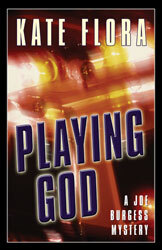 now-defunct Mid-Atlantic Mystery Conference in Philadelphia. I was meeting a detective from Newark, Delaware for breakfast. He’d become an internet penpal when I was seeking information from a forensics forum about doing an exhumation of a buried body. At that breakfast, he told me about a case in his town where two college students, she pregnant, he the father, dealt with their unwanted child by meeting at a motel in Newark, delivering the baby, killing it, leaving it in a dumpster, and going back to their respective schools. The heart of his story, for me, was the impact that investigating that case had on the primary detective. He was then the father of a young baby himself, and finding that tiny body, matching the wound on the child’s head to furniture in the room, and then dealing with a case where politics trumped justice. The impact on the detective was so severe he had a heart attack and had to retire.
now-defunct Mid-Atlantic Mystery Conference in Philadelphia. I was meeting a detective from Newark, Delaware for breakfast. He’d become an internet penpal when I was seeking information from a forensics forum about doing an exhumation of a buried body. At that breakfast, he told me about a case in his town where two college students, she pregnant, he the father, dealt with their unwanted child by meeting at a motel in Newark, delivering the baby, killing it, leaving it in a dumpster, and going back to their respective schools. The heart of his story, for me, was the impact that investigating that case had on the primary detective. He was then the father of a young baby himself, and finding that tiny body, matching the wound on the child’s head to furniture in the room, and then dealing with a case where politics trumped justice. The impact on the detective was so severe he had a heart attack and had to retire.
Pondering on that, a detective deeply careworn and damaged by decades of the terrible things people did to each other, was born. Grouchy, solitary, with the hide of a rhinoceros, but still with chinks that made him vulnerable, Joe Burgess was a detective I, and I hope my reader, could care about. But the idea of him, like yeast beginning to work, was born at that breakfast.
One of the stories I told my friend’s son was about one of my “books in the drawer,” those that are still unpublished. Character and story do, literally, come in my sleep. In this case, in The Darker the Night, the detective, Rick O’Leary, literally came into my mind, sat down beside me on a barstool, and began to talk. I was fascinated by who he was, what had shaped him, and what was the story being that moment on the barstool.
O’Leary tossed back the shot of Jack, landing the empty glass a little unsteadily on the bar where it joined three others. A quartet, he thought idly. A fucking drunkard’s quartet. He squinted his eyes and stared at the line of glasses, smudgy golden gleams in the bar’s soft light. They weren’t going to make music for him tonight. Or do anything else for that matter. It was one of those perfectly fucked-up nights when he knew however many of these he drank, there would be no nirvana. No moments of drunken happiness. No wave of blessed relief from the darkness inside his head.
So, fellow writers, a bit of advice, if you’re interested. Since inspiration for stories can come from anywhere, try to be open to them. It may be a scrap of conversation overheard at Dunkin’ Donuts or in the next dressing room. It might be something you see while driving, like a car parked in an unusual place with all four doors open and no one around. It might be something you read in the paper, like that Ann Landers column. It might be a story someone tells you. Wondering “what’s that about” is something we do all the time. Taking a scrap and asking the “What if” questions can lead to a new character, situation or story. And if some character wants to interrupt your sleep, sit down on a barstool, and tell you about themselves? Wake up and listen.
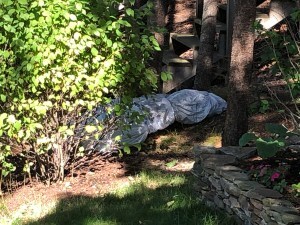
The photo I couldn’t help taking. Actually two shrubs shrouded in plastic to protect my car, but looking like something else entirely.
September 16, 2022
Weekend Update: September 17-18, 2022
 Next week at Maine Crime Writers there will be posts by Kate Flora (Monday), Maggie Robinson (Tuesday), Sandra Neily (Thursday), and Maureen Milliken (Friday).
Next week at Maine Crime Writers there will be posts by Kate Flora (Monday), Maggie Robinson (Tuesday), Sandra Neily (Thursday), and Maureen Milliken (Friday).
In the news department, here’s what’s happening with some of us who blog regularly at Maine Crime Writers:
Vaughn C Hardacker will sell and sign books at Gentile Hall in the University of Maine, Presque Isle as part of Homecoming Weekend on September 24.
An invitation to readers of this blog: Do you have news relating to Maine, Crime, or Writing? We’d love to hear from you. Just comment below to share.
And a reminder: If your library, school, or organization is looking for a speaker, we are often available to talk about the writing process, research, where we get our ideas, and other mysteries of the business, along with the very popular “Making a Mystery” with audience participation, and “Casting Call: How We Staff Our Mysteries.” We also do programs on Zoom. Contact Kate Flora
September 15, 2022
My Heroines Have Always Been . . .
Kaitlyn Dunnett/Kathy Lynn Emerson here, with yet another nostalgia piece. If I seem to write a lot of these, chalk it up to my age (75 next month) and the fact that I’ve already written close to 300 posts for this blog. I’ve got to go with the ideas that come to me.
So, this one goes back to my childhood in the 1950s. We had a television set quite early on. Not everyone did. I should add that we listened to the radio a lot, too. My mother always had Don MacNeil’s Breakfast Club playing on the radio in the morning. We tuned to WVOS (Voice of Sullivan County) for local news. It was in a broadcast on that station that I heard that my grandparents’ farm (sold out of the family and standing empty) had burned down. Not too much later, I listened to DJs out of New York City while I did my homework. Cousin Brucie was part of a lot of teenagers’ lives.
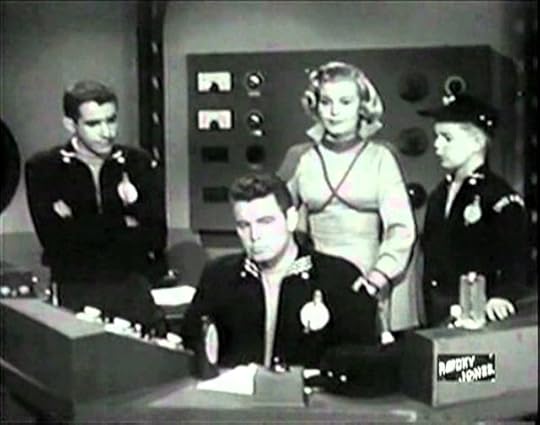
That said, TV shows were what captured my imagination early on and led to my first attempts at writing what today would be called fan-fic. 1950s television was pretty clean-cut. I can’t remember ever being told I couldn’t watch a program, although one time when I was babysitting, the kid’s mother asked me to change the channel from a movie that was on. I wish I could remember what one. It was probably pretty harmless.

I watched a lot of TV with my mother. Her favorites were Perry Mason and The Mel Tormé Show and I blithely co-opted real people as well as characters to play roles in my imaginary worlds. Early on I watched Lassie and Howdy Doody and I suppose I watched The Mickey Mouse Club, although I don’t really remember that. I know I was (with two friends) a member of the Mighty Mouse Fan Club. There were lots of westerns. I remember watching The Lone Ranger, Maverick, Wagon Train, and Annie Oakley, but none of those characters made it into the fan-fic. Neither did the heroes of various series that were part of the Disney franchise—Swamp Fox, Zorro, Davy Crockett, and others I can’t now recall. I did, of course, have a coonskin cap.
The shows that made the biggest impression on me had ensemble casts and featured, albeit in secondary roles, women. Dale Evans got almost equal billing with Roy Rogers. On Sky King there was Sky’s niece, Penny. I did like westerns, but my real favorites were the early space operas. Flash Gordon and Dale Arden turned up on TV when old movies were shown, but there were also a few new shows that featured trips into outer space long before the dawn of Star Trek.
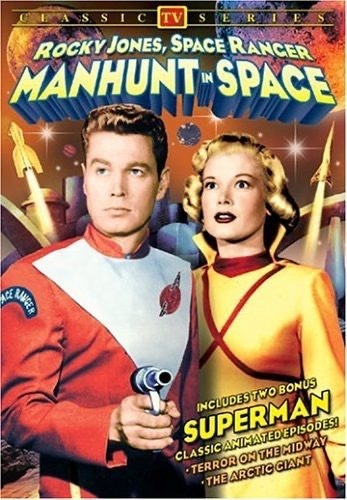
Most people today have never heard of Rocky Jones, Space Ranger. It ran from January 1954 to December 1955 for 39 episodes. I have to admit that the episodes available on DVDs and streaming don’t hold up all that well. But at the time they were just the sort of thing to spark a kid’s imagination. I loved everything about that show, from the sound effects of the rocket ship taking off to the fact that there was not only a strong female character in the crew but also a kid in a recurring role. In fact, there were several episodes in which the kid, Bobby, and a girl from another planet were responsible for saving the day.

The Orbit Jet was very spacious inside. So was the space station it docked with on long trips. But getting back to female role models—Vena Ray was Uhura before there was an Uhura. She had a responsible job as navigator aboard the Orbit Jet and did a pretty good job of looking out for herself. This being the ’50s, the costume department put her in a very short skirt, something that remained a hallmark of Science Fiction programming for far too long. Still—career woman. No husband. Not expected to cook or clean for the guys. No wonder I liked her.
Interestingly enough, one of the principal villains in the series was also female, an evil planetary ruler named Cleolanta.

What TV shows do you remember from your preteen years?

Kathy Lynn Emerson/Kaitlyn Dunnett has had sixty-four books traditionally published and has self published others, including several children’s books. She won the Agatha Award and was an Anthony and Macavity finalist for best mystery nonfiction of 2008 for How to Write Killer Historical Mysteries and was an Agatha Award finalist in 2015 in the best mystery short story category. She was the Malice Domestic Guest of Honor in 2014. Her most recent publications are The Valentine Veilleux Mysteries (a collection of three short stories and a novella, written as Kaitlyn) and I Kill People for a Living: A Collection of Essays by a Writer of Cozy Mysteries (written as Kathy). She maintains websites at www.KaitlynDunnett.com and www.KathyLynnEmerson.com.
September 14, 2022
Reminiscences of Summer 2022

Vaughn C. Hardacker
Vaughn C. Hardacker here: I was writing this on September 12, 2021, and here in the north country, we are starting to see some of the trees donning their autumnal finery. Autumn (Fall if you prefer) has always been my favorite season. I believe it’s because when the trees approach their peak color, and the sky is a stunning blue and cloudless, the entire landscape seems to be at its brightest. It’s always surprised me how such a bright and beautiful season is, in reality, the precursor to the cold, dark, dreary winter. I’ve always thought that fall is Mother Nature’s last opportunity to dress up before her long winter nap.
It also makes me pause and review the summer past. The past year has been anything but boring up in The County. It started in its usual way. The sun sets around 3:00 pm, and it is full dark by 3:30. In my pre-retirement days, I drove to work in the dark, worked in a windowless office, and then drove home in the dark. It made me feel like a mushroom– kept in the dark and fed B. S.
Then in February, the nonprofit company that runs the Maine Veterans Homes announced its intention to close the homes in Caribou and Machias. The closure decision was made in October but kept secret until February. Why the delay in the announcement? I can only think of one reason. They feared that if they announced the pending closure (it was to happen in May), staff would immediately start searching for jobs elsewhere. In short, they were screwing their employees. This action lit a three-foot fire under the local veteran community. When Troy Jackson (Democrat from Allagash), President of the Maine State Senate, introduced legislation to stop the closures, county veterans (regardless of political affiliation) rallied around him and went to work. At the risk of sounding cynical, the Maine Veterans Homes should have known better than to attempt such a wrong move during an election year. To make this short, the legislation passed the Maine Legislation with 100% bipartisan support.
In June, I was asked if I would be willing to join a group of veterans for a whirlwind trip to

Wreath Ceremony June 17, 2022
Washington, D.C. We left Caribou at six o’clock on Thursday morning, June 16, and drove all day and night, stopping only for gas and food. We arrived in Washington around 1:30 am on Friday the 17th. We checked into our hotel, slept for a few hours, and performed a wreath ceremony at The Tomb of The Unknown at Arlington Cemetery. The temperature that day hit 100 degrees Fahrenheit, but as we watched the honor marching in darl blue uniforms in the blistering heat, we knew that we had no business complaining. I had an epiphany of sorts. We may never again have an unknown… the military now routinely takes DNA from all of its members and stores it in a database.
It made me think of my first friend in Vietnam. Joe Zutterman, from Marysville, Kansas, who took me under his wing when I arrived in-country on January 29, 1968. Joe had some

Visiting Joe Zutterman’s name on Vietnam Wall, December 2016
trouble early in his Marine career and had been demoted. He was due to return home on April 20, 1968. He was offered a promotion to Sergeant (E-5) if he would extend his tour for an additional six months. On April, the first day of his extension, the helicopter in which Joe was door gunner was blown up. When I visited the wall, Joe was listed as MIA (Assumed Dead) Body Not Recovered. I saw the wreckage; all the recovery crew found were bits and pieces. The crew and Joe Zutterman’s remains have never been recovered. With DNA technology, all that is required is a small piece of the body, and identity can be determined.
Now that I’m thinking of Joe and how his death made me realize that the movies have no idea what war is like. Wouldn’t it be great if, after a battle, the director could shout, “Cut…that’s a wrap…” All the participants, dead and alive, got up and went home. I recently read somewhere that since the American Revolution, there have only been 23 years in which there has not been a war in which our armed forces were involved.
Maybe no longer being an unknown soldier isn’t a bad thing after all. This winter, on those cold, dark nights, I’ll big this blog post up, think of Joe… and feel warm all over.
Reminiscences of Summer 2021

Vaughn C. Hardacker
Vaughn C. Hardacker here: I was writing this on September 12, 2021, and here in the north country, we are starting to see some of the trees donning their autumnal finery. Autumn (Fall if you prefer) has always been my favorite season. I believe it’s because when the trees approach their peak color, and the sky is a stunning blue and cloudless, the entire landscape seems to be at its brightest. It’s always surprised me how such a bright and beautiful season is, in reality, the precursor to the cold, dark, dreary winter. I’ve always thought that fall is Mother Nature’s last opportunity to dress up before her long winter nap.
It also makes me pause and review the summer past. The past year has been anything but boring up in The County. It started in its usual way. The sun sets around 3:00 pm, and it is full dark by 3:30. In my pre-retirement days, I drove to work in the dark, worked in a windowless office, and then drove home in the dark. It made me feel like a mushroom– kept in the dark and fed B. S.
Then in February, the nonprofit company that runs the Maine Veterans Homes announced its intention to close the homes in Caribou and Machias. The closure decision was made in October but kept secret until February. Why the delay in the announcement? I can only think of one reason. They feared that if they announced the pending closure (it was to happen in May), staff would immediately start searching for jobs elsewhere. In short, they were screwing their employees. This action lit a three-foot fire under the local veteran community. When Trot Jackson (Democrat from Allagash), President of the Maine State Senate, introduced legislation to stop the closures, county veterans (regardless of political affiliation) rallied around him and went to work. At the risk of sounding cynical, the Maine Veterans Homes should have known better than to attempt such a wrong move during an election year. To make this short, the legislation passed the Maine Legislation with 100% bipartisan support.
In June, I was asked if I would be willing to join a group of veterans for a whirlwind trip to

Wreath Ceremony June 17, 2022
Washington, D.C. We left Caribou at six o’clock on Thursday morning, June 16, and drove all day and night, stopping only for gas and food. We arrived in Washington around 1:30 am on Friday the 17th. We checked into our hotel, slept for a few hours, and performed a wreath ceremony at The Tomb of The Unknown at Arlington Cemetery. The temperature that day hit 100 degrees Fahrenheit, but as we watched the honor marching in darl blue uniforms in the blistering heat, we knew that we had no business complaining. I had an epiphany of sorts. We may never again have an unknown… the military now routinely takes DNA from all of its members and stores it in a database.
It made me think of my first friend in Vietnam. Joe Zutterman, from Marysville, Kansas, who took me under his wing when I arrived in-country on January 29, 1968. Joe had some

Visiting Joe Zutterman’s name on Vietnam Wall, December 2016
trouble early in his Marine career and had been demoted. He was due to return home on April 20, 1968. He was offered a promotion to Sergeant (E-5) if he would extend his tour for an additional six months. On April, the first day of his extension, the helicopter in which Joe was door gunner was blown up. When I visited the wall, Joe was listed as MIA (Assumed Dead) Body Not Recovered. I saw the wreckage; all the recovery crew found were bits and pieces. The crew and Joe Zutterman’s remains have never been recovered. With DNA technology, all that is required is a small piece of the body, and identity can be determined.
Now that I’m thinking of Joe and how his death made me realize that the movies have no idea what war is like. Wouldn’t it be great if, after a battle, the director could shout, “Cut…that’s a wrap…” All the participants, dead and alive, got up and went home. I recently read somewhere that since the American Revolution, there have only been 23 years in which there has not been a war in which our armed forces were involved.
Maybe no longer being an unknown soldier isn’t a bad thing after all. This winter, on those cold, dark nights, I’ll big this blog post up, think of Joe… and feel warm all over.
September 13, 2022
Writing Alone and Celebrating Community
I retreated to a lake in York County at the end of August, taking along my computer, comfy clothes and some food. My only job for a couple of days was to write, write some more, and talk about writing with the other four retreat-goers. I did a lot of work on a revision project and refined a query letter for a finished manuscript, doodled some ideas for short stories and read several written by others.
It was heaven.
I’ve done writing retreats before, both with others and on my own. I’ve almost always landed in beautiful places that feed my soul. 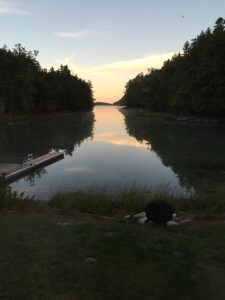 One year I went to East Boothbay for the Maine Writers and Publisher’s Alliance’s fall writing retreat, where I holed up in a tiny cottage and wrote all day while the other participants were attending workshops, joined the group for dinner and readings, then retreated back to my little nest and wrote deep into the night. The instructional time no doubt would have been helpful, but what I craved was time to write, alone and away from my day-to-day routine.
One year I went to East Boothbay for the Maine Writers and Publisher’s Alliance’s fall writing retreat, where I holed up in a tiny cottage and wrote all day while the other participants were attending workshops, joined the group for dinner and readings, then retreated back to my little nest and wrote deep into the night. The instructional time no doubt would have been helpful, but what I craved was time to write, alone and away from my day-to-day routine.
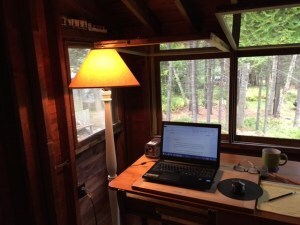
My writing space on Peaks.
I’ve relished solo retreats in Stockton Springs in the dead of winter and West Bath in the fall, on a hot July weekend at a cottage on a lake in Waterford, and during the spring warbler migration at a friend’s house on Cliff Island. Several years I’ve been blessed with quiet time to write at a magical place near my old house on Peaks Island.
And as regular readers of this blog know, each August I spend two weeks at a little cottage on the shore in Brooklin, a vacation from my day job and a chance to dive head-first into my writing.
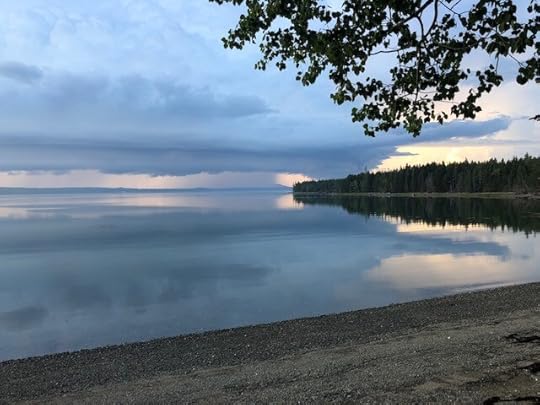
The view from my writing spot in Brooklin.
Last weekend’s retreat was a wonderful hybrid. A small group of writers gathered at a spacious lakefront house for two days. We each staked out writing space where we spent the daylight hours by ourselves, writing, revising, writing some more. We convened in the evening to read from our work and talk about where we’re trying to go with it. The evening conversations were freewheeling and constructive, hilarious and dead serious. I came away with a lot to chew on in the coming months.
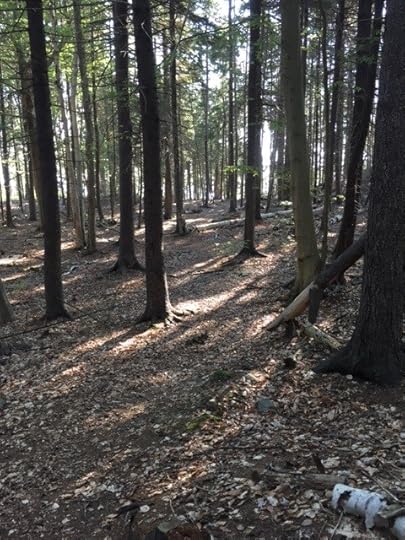
I usually walk morning and afternoon when on a writing retreat. The Daveis Sanctuary on Peaks is one of my go-to spots.
Writing’s a solitary endeavor. We’re on our own when we sit down at the keyboard, alone with our thoughts, our characters, our goals and our anxiety about not being able to pull it off, whatever “it” is. But when it’s time to take a break from putting words to page, I’m grateful to my writing community—this blog, gatherings like the Maine Crime Wave and colleagues with whom I can spend time at a lake house—helping each other keep it all in perspective.
Brenda Buchanan brings years of experience as a journalist and a lawyer to her crime fiction. She has published three books featuring Joe Gale, a newspaper reporter who covers the crime and courts beat. She is now hard at work on new projects. FMI, go to http://brendabuchananwrites.com
NOTES: For those looking to engage with the writing community, MWPA and Colby College are sponsoring a Literary Festival in Portland and Waterville at the end of this month. FMI: https://www.mainewriters.org/maine-lit-fest
Also, this year’s MWPA Fall Writing Retreat will be October 14-16 in Phippsburg. FMI: https://www.mainewriters.org/harvest-writers-retreat
Whence Ideas, That’s the Question
“Where do you get your ideas?” That’s the question writers most often hear from readers—and even from friends who aren’t readers. Every writer answers it a different way, but here’s a general overview. Ideas pop up everywhere. For example, a news story, an overheard (read: eavesdropped) conversation, a suspicious character on the street, or a couple seen arguing in a restaurant. I’ve begun books based on only a location or a particular character, an object, or a plot thread.
Not all ideas can be massaged into a plot and characters in a viable story. I’ve dumped a ton of what at the time I thought were terrific ideas but that led me nowhere. But some ideas do lead to completed books.
Once, my husband and I vacationed in the Yucatan area of Mexico on what is called the Mayan Riviera. After some beach time, we toured two of the ancient cities. Chichen-Itza offers the most famous Mayan pyramid and is mostly restored. Fascinating but not inspiring. Another tour led by a Mayan guide to Cobá, an un-restored ruin deep in the jungle, flooded me with ideas and questions. I pictured archeologists working alongside nearby Mayan villagers.
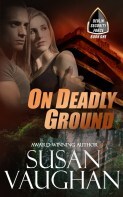
When the guide said some of the buildings’ destruction was from earthquakes, I thought: what if the people believed an artifact with a curse caused quakes. These musings eventually led to my romantic thriller On Deadly Ground, set in a fictional Central American country with a pending earthquake.

The picture here at Cobá is of the temple dedicated to the god of commerce, shaped like a beehive because one of their big trading commodities was honey. A similar temple appears in the book.
For the second book in the series, another romantic thriller, Ring of Truth, an idea I had years ago about a puzzle ring and a news article about lost crown jewels set my plot in motion.
Also, I wanted a story for Mara Marton, the researcher introduced
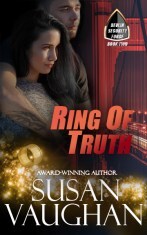 in On Deadly Ground. Puzzling over these seemingly unconnected ideas led me to the unlikely hero of the story and the threads of the overall plot of Ring of Truth. What if Mara’s deceased father had been the insurance investigator tasked with solving the theft of the crown jewels of Gramornia, and what if the heist’s mastermind had been ex-con Cortez Jones’s father? What if they had to work together to find the jewels?
in On Deadly Ground. Puzzling over these seemingly unconnected ideas led me to the unlikely hero of the story and the threads of the overall plot of Ring of Truth. What if Mara’s deceased father had been the insurance investigator tasked with solving the theft of the crown jewels of Gramornia, and what if the heist’s mastermind had been ex-con Cortez Jones’s father? What if they had to work together to find the jewels?
 Another news article led to the plot of the third book in the same series, Cleopatra’s Necklace. Years ago, Egypt’s top archeologist, Zahi Hawass, claimed to have found the tomb of Cleopatra and Mark Antony at a site near the Mediterranean Sea. Hawass displayed artifacts found inside the tomb, exciting everyone about the possibilities. No one has reported any further discoveries since. Upheaval and continued unrest in Egypt may have stopped the search, or that particular tomb turned out not to be the Queen of the Nile’s resting place.
Another news article led to the plot of the third book in the same series, Cleopatra’s Necklace. Years ago, Egypt’s top archeologist, Zahi Hawass, claimed to have found the tomb of Cleopatra and Mark Antony at a site near the Mediterranean Sea. Hawass displayed artifacts found inside the tomb, exciting everyone about the possibilities. No one has reported any further discoveries since. Upheaval and continued unrest in Egypt may have stopped the search, or that particular tomb turned out not to be the Queen of the Nile’s resting place.
A disappointment, but that didn’t stop me from imagining what might be in Cleopatra’s tomb. What if the tomb contained jewels and scepters and other treasures similar to those from the tomb of King Tut? And what if while these were on tour protected by Devlin Security Force, they were stolen? The typical necklace pictured on images of Cleopatra became the dingus, the Maltese Falcon, if you will, that Thomas Devlin himself must find, and his heroine, an old flame, had to be named Cleo.
You may have noticed that my plot musings seem to begin with “What if” questions. I don’t think I’m alone among writers in asking that question.
And here’s a final example. When I began writing for publication, rejections from editors often mentioned weak conflict. I saw that as a challenge. What would be the strongest conflict that would prevent my heroine from becoming involved with anyone? What if she believed that she was cursed, that everyone she became close to would die?

Starting with that premise, I was able to create the characters and plot of what became my first published novel, Dangerous Attraction. I received the publishing rights to that book and revised and updated it for re-publication as Always a Suspect.
*** Find more about my books and sign up for my newsletter at www.susanvaughan.com.
Lea Wait's Blog
- Lea Wait's profile
- 509 followers



